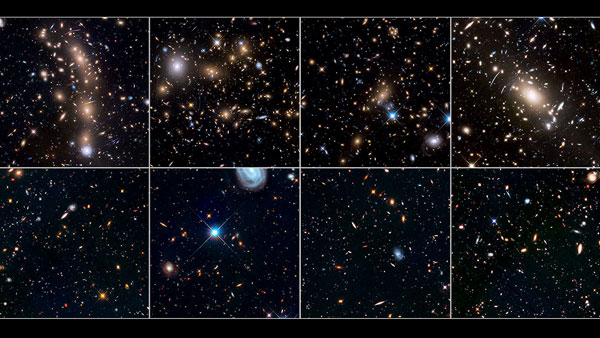The recent discovery of a new type of tiny, star-forming galaxy is the latest in a zoo of detections shedding light on our early universe. What can we learn from the unique “little blue dots” found in archival Hubble data?

NASA
Peas, Berries, and Dots

Richard Nowell – Carolin Cardamone
As telescope capabilities improve and we develop increasingly deeper large-scale surveys of our universe, we continue to learn more about small, faraway galaxies. In recent years, increasing sensitivity first enabled the detection of “green peas” — luminous, compact, low-mass (<10 billion solar masses; compare this to the Milky Way’s ~1 trillion solar masses!) galaxies with high rates of star formation.
Not long thereafter, we discovered galaxies that form stars similarly rapidly, but are even smaller — only ~3–30 million solar masses, spanning less than ~3,000 light-years in size. These tiny powerhouses were termed “blueberries” for their distinctive color.
Now, scientists Debra and Bruce Elmegreen (of Vassar College and IBM Research Division, respectively) report the discovery of galaxies that have even higher star formation rates and even lower masses: “little blue dots”.
Exploring Tiny Star Factories
The Elmegreens discovered these unique galaxies by exploring archival Hubble data. The Hubble Frontier Fields data consist of deep images of six distant galaxy clusters and the parallel fields next to them. It was in the archival data for two Frontier Field Parallels, those for clusters Abell 2744 and MAS J0416.1-2403, that the authors noticed several galaxies that stand out as tiny, bright, blue objects that are nearly point sources.

Elmegreen & Elmegreen 2017
The authors performed a search through the two Frontier Field Parallels, discovering a total of 55 little blue dots with masses spanning 105.8–107.4, specific star formation rates of >10-7.4, and redshifts of 0.5 < z < 5.4.
Exploring these little blue dots, the Elmegreens find that the galaxies’ sizes tend to be just a few hundred light-years across. They are gas-dominated; gas currently outweighs stars in these galaxies by perhaps a factor of five. Impressively, based on the incredibly high specific star formation rates observed in these little blue dots, they appear to have formed all of their stars in the last 1% of the age of the universe for them.
An Origin for Globulars?

Log-log plot of star formation rate vs. mass for the three main groups of little blue dots (red, green, and blue markers), a fourth group of candidates with different properties (brown markers), and previously discovered local blueberry galaxies. The three main groups of little blue dots appear to be low-mass analogs of blueberries.
Elmegreen & Elmegreen 2017
Intriguingly, this rapid star formation might be the key to answering a long-standing question: where do globular clusters come from? The Elmegreens propose that little blue dots might actually be an explanation for the origin of these orbiting, spherical, low-metallicity clusters of stars.
The authors demonstrate that, if the current star formation rates observed in little blue dots were to persist for another ~50 Myr before feedback or gas exhaustion halted star production, the little blue dots could form enough stars to create clusters of roughly a million solar masses — which is large enough to explain the globular clusters we observe today.
If little blue dots indeed rapidly produced such star clusters in the past, the clusters could later be absorbed into the halos of today’s spiral and elliptical galaxies, appearing to us as the low-metallicity globular clusters that orbit large galaxies today.
Citation
Debra Meloy Elmegreen and Bruce G. Elmegreen 2017 ApJL 851 L44. doi:10.3847/2041-8213/aaa0ce
Related Journal Articles
This post originally appeared on AAS Nova, which features research highlights from the journals of the American Astronomical Society.
 0
0
Comments
You must be logged in to post a comment.